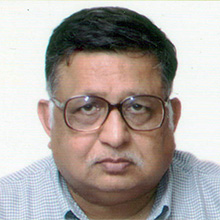Plenary Speaker - Ashok Singhvi
Download
Note: Video unavailable for this plenary
Biography
A.K. Singhvi, Geosciences Division, Physical Research Laboratory, Ahmadabad, India
2aksprl11@gmail.com
Ashok Kumar Singhvi has a PhD in nuclear physics, after which he joined the Geosciences group at the Physical Research Laboratory, India, where he developed a luminescence dating program. He was amongst the early entrants to this field and has contributed to its methodological development and its various applications, including the dating of deserts, which he pioneered. Other new applications he developed relate to the dating of coastal deposits, pedogenic carbonates, glacial ice, fulgurites, termites, and several others. He has worked in numerous deserts of the world and his studies on deserts have changed some of the conventional concepts about their response to climate, e.g. that the expansion and contraction of deserts was not synchronous. He has extensively contributed to studies on the Indian Quaternary and has provided first order chronometry for most of the Indian surface. He has authored about 200 papers and edited/authored about 12 conference proceedings/books.
He has been a member of the PAGES SSC and the Science Program Committee of IYPE, and was co-leader of IGCP 349 and 413 on deserts, evolution and the monsoon. Singhvi conceptualized the Indian invitation to PAGES-OSM in Goa. He is a Fellow of all the Indian science academies, the Geological Society of London, and the Third World Academy of Sciences. The Geological Society of America awarded him the Farouk El Baz Prize for his contributions to desert research and he has received several Indian recognitions as well.
Abstract: Land-sea correlation: Pitfalls and remedies
To date, most land–sea or land–land correlations have been made, and are being made, by assuming a synchronicity of events, processes, and resulting changes on land and in the oceans. In such studies, it is implicitly assumed that, like marine or ice core records, terrestrial archives are created/accreted continuously, and that terrestrial sediment attributes behave in the same manner as those of the ocean or ice proxies.
Based on this assumption, identical periodicities in the response of terrestrial systems have been inferred in numerous cases and major conclusions have been drawn. A further complication is the use of multi-proxy data with the simplistic assumption that all proxies respond to forcing in a synchronous manner and that the larger the number of proxies, the better. Direct dating of geological archives using modern chronometric methods have necessitated changes in this conventional wisdom. I shall present three chronometrically constrained case studies of dryland responses to monsoon changes:
1) clear evidence of lagged Aeolian system response
2) spatially different soil formation chronologies on the same stratigraphic boundaries
3) variable timing of the desiccation of lacustrine systems within a small spatial domain
These cases defy conventional wisdom and suggest the importance of determining temporal and spatial gradients and proxy responses based on robust chronologies. The need now is to more completely understand proxies by determining their thresholds, response styles, and timescales by establishing sound chronologies. Blending field evidence with chronometry is essential, along with recognition of the nature of events being dated by a particular method. This information will be needed for proper land use-landcover planning and for climate modeling under anticipated environmental change scenarios. A powerful yet simple and analytical approach to this problem is one of system dynamics that explicitly includes feedbacks, delays, and response types. Such approaches will be crucial for paleoscience to truly serve as a compass for future Earth.
















